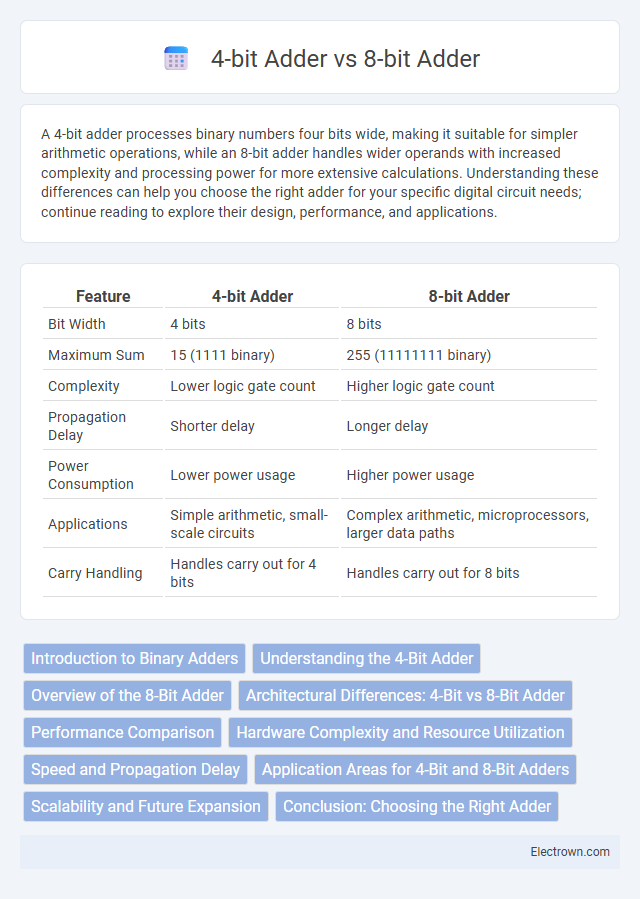A 4-bit adder processes binary numbers four bits wide, making it suitable for simpler arithmetic operations, while an 8-bit adder handles wider operands with increased complexity and processing power for more extensive calculations. Understanding these differences can help you choose the right adder for your specific digital circuit needs; continue reading to explore their design, performance, and applications.
Table of Comparison
| Feature | 4-bit Adder | 8-bit Adder |
|---|---|---|
| Bit Width | 4 bits | 8 bits |
| Maximum Sum | 15 (1111 binary) | 255 (11111111 binary) |
| Complexity | Lower logic gate count | Higher logic gate count |
| Propagation Delay | Shorter delay | Longer delay |
| Power Consumption | Lower power usage | Higher power usage |
| Applications | Simple arithmetic, small-scale circuits | Complex arithmetic, microprocessors, larger data paths |
| Carry Handling | Handles carry out for 4 bits | Handles carry out for 8 bits |
Introduction to Binary Adders
A 4-bit adder processes binary numbers in chunks of four bits, making it suitable for simple arithmetic operations with smaller data sizes, while an 8-bit adder handles eight-bit binary inputs, enabling calculations involving larger binary values. The main difference lies in their bit width, which directly affects the adder's capacity to manage overflow and compute sums more efficiently in wider bit-length operations. Both types are fundamental components in digital circuits, forming the basis for arithmetic logic units (ALUs) and enabling binary addition essential for computational tasks.
Understanding the 4-Bit Adder
A 4-bit adder processes binary numbers of four bits each, enabling the addition of values ranging from 0 to 15, whereas an 8-bit adder handles eight-bit numbers, expanding the range to 0-255 for higher precision calculations. Understanding the 4-bit adder involves recognizing its role in computational circuits as a fundamental building block used for simple arithmetic operations and the foundation for larger adders. Your applications benefit from grasping how carry bits propagate through the 4-bit adder, affecting speed and complexity compared to the more advanced 8-bit version.
Overview of the 8-Bit Adder
The 8-bit adder is an arithmetic circuit designed to add two 8-bit binary numbers, producing a sum and a carry-out bit. Compared to the 4-bit adder, it handles twice the amount of data, making it essential for more complex digital computations and microprocessor operations. Its design often incorporates cascading multiple 4-bit adders or using a single 8-bit ripple carry or carry look-ahead architecture for faster addition.
Architectural Differences: 4-Bit vs 8-Bit Adder
A 4-bit adder processes binary numbers 4 bits wide, typically using a ripple carry architecture with fewer full adder stages, resulting in lower complexity and faster computation for small operations. An 8-bit adder doubles the input width, requiring additional full adder units and more complex carry propagation techniques, which can increase delay and resource usage but allows for handling larger binary numbers. Your choice between a 4-bit and 8-bit adder depends on the required data size, speed constraints, and hardware efficiency in your digital circuit design.
Performance Comparison
An 8-bit adder processes twice the amount of binary data compared to a 4-bit adder, resulting in higher computational throughput but increased propagation delay due to more gate levels. The 4-bit adder exhibits faster operation with lower power consumption, making it suitable for simple, low-latency tasks. In contrast, the 8-bit adder enhances performance in complex arithmetic operations by handling larger data width, though it demands more silicon area and power resources.
Hardware Complexity and Resource Utilization
A 4-bit adder requires fewer logic gates and less silicon area compared to an 8-bit adder, resulting in lower hardware complexity and reduced power consumption. The 8-bit adder, while doubling the bit-width, significantly increases resource utilization including more full adders and interconnections, impacting overall chip area and latency. Your choice between these depends on the required computational precision balanced against hardware constraints.
Speed and Propagation Delay
A 4-bit adder typically exhibits lower propagation delay and faster operation compared to an 8-bit adder due to fewer stages of carry propagation. In an 8-bit adder, the increased number of bits causes a longer carry chain, resulting in greater latency and reduced speed. Understanding the impact of bit width on your adder's propagation delay is crucial for optimizing processing speed in digital circuits.
Application Areas for 4-Bit and 8-Bit Adders
4-bit adders are commonly used in simple arithmetic operations within low-power embedded systems, such as basic microcontrollers and digital clocks, where limited data size and speed are sufficient. In contrast, 8-bit adders find applications in more complex microprocessors, digital signal processors, and early computing systems that require handling larger data buses and improved computational performance. Your choice between 4-bit and 8-bit adders depends on the design requirements for processing speed, data width, and power consumption in specific electronic devices or computing systems.
Scalability and Future Expansion
A 4-bit adder offers limited scalability, suitable for basic arithmetic tasks but insufficient for complex or large-scale computations. An 8-bit adder provides enhanced capacity, supporting more extensive data processing and facilitating future expansion in digital systems. Your choice between the two directly impacts the ease of upgrading and integrating more advanced features in evolving applications.
Conclusion: Choosing the Right Adder
Selecting between a 4-bit adder and an 8-bit adder depends on the required data width and processing speed in digital circuits. A 4-bit adder offers simplicity and lower power consumption for small-scale applications, while an 8-bit adder supports larger binary numbers and improved computational accuracy. Optimizing system performance involves balancing bit width with resource constraints and the specific arithmetic demands of the application.
4-bit adder vs 8-bit adder Infographic

 electrown.com
electrown.com